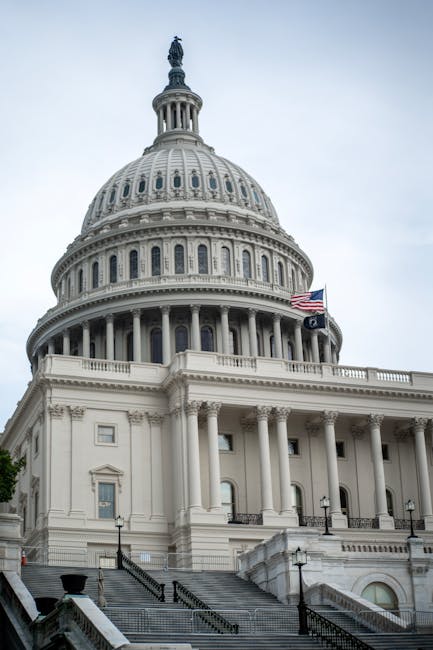The Current Climate: Uncertainty and Potential Changes
Federal employees are facing a period of considerable uncertainty regarding their retirement benefits. A series of legislative developments and proposals are reshaping the landscape, creating a complex environment requiring careful attention and proactive planning. The ongoing debate revolves around balancing fiscal responsibility with the long-term security of the federal workforce.
The Reconciliation Bill: A Key Focus of Debate
At the heart of the current discussion is the ongoing reconciliation bill. This bill, part of broader budget and policy negotiations, has been the subject of intense debate amongst lawmakers, federal employee unions, and advocacy groups. Early versions of the bill contained proposals that sparked significant concern among federal employees.
What Was Proposed, and What Was Avoided
Initial proposals included potentially detrimental changes to federal retirement benefits, such as:
- Reducing or Eliminating Cost-of-Living Adjustments (COLAs): This would have significantly impacted the purchasing power of current and future retirees.
- Increasing Employee Contributions to the Federal Employees Retirement System (FERS): This would directly reduce take-home pay for current employees.
- Altering Annuity Calculation Formulas: Modifications to the way annuities are calculated could have resulted in lower lifetime benefits.
Fortunately, thanks to the diligent efforts of advocacy groups and unions, the most severe of these proposed cuts were successfully blocked in the House version of the reconciliation bill. However, it’s crucial to remember that the legislative process is far from over.
AFGE’s Vital Role in Protecting Federal Retirement
The American Federation of Government Employees (AFGE), representing a significant portion of the federal workforce, played a crucial role in advocating against these proposed cuts. Their efforts involved:
- Lobbying and Advocacy: Directly engaging with lawmakers to express concerns and propose alternatives.
- Public Awareness Campaigns: Educating the public about the importance of federal retirement benefits.
- Coordination with Allied Organizations: Working collaboratively with other groups to amplify their voice.
AFGE’s efforts emphasized the vital role federal retirement benefits play in attracting and retaining a skilled workforce. Reducing benefits, they argued, would not only harm current employees and retirees but also make federal service less appealing to future generations, ultimately impacting the quality of public service.
The “New Deal” for Federal Retirement: Examining FERS Proposals
Alongside the reconciliation bill, a new wave of proposals aimed at reshaping the Federal Employees Retirement System (FERS) has emerged, often referred to as a “new deal” for federal retirement. These proposals reflect a changing fiscal environment and evolving expectations surrounding retirement security, but also introduce potential changes that require careful consideration.
Key Components of the Proposed FERS Changes
- Revised Annuity Calculations: Discussions are underway regarding shifting from the current “high-3” calculation (averaging the highest three years of salary) to a “high-5” calculation. This change would generally result in lower annuities for future retirees.
- Cost-of-Living Adjustments (COLAs): Some proposals suggest limiting or eliminating COLAs for FERS retirees, particularly those under a certain age, or applying reduced rates.
- Increased Employee Contributions: A recurring theme is the suggestion of higher employee contributions to the FERS pension fund, impacting current workers’ take-home pay.
- Emphasis on the Thrift Savings Plan (TSP): There’s a growing focus on the TSP as a core element of retirement, with potential proposals to enhance matching contributions or encourage greater employee participation to offset reductions in defined benefit pensions.
What Lies Ahead: The Senate’s Role and Ongoing Uncertainty
While the House reconciliation bill doesn’t currently include the most drastic benefit cuts, the legislative journey is far from complete. The bill now moves to the Senate, where further amendments and negotiations are anticipated. Lawmakers may revisit previously debated proposals concerning COLAs, annuity calculations, and employee contributions.
Federal employee organizations remain vigilant, closely monitoring the process and preparing for renewed efforts to potentially reduce retirement benefits. Proactive engagement and informed participation are crucial for protecting the interests of federal workers.

Practical Steps for Federal Employees: Planning for the Future
The evolving policy landscape necessitates that current and future federal employees proactively understand their retirement benefits and assess how potential changes could affect their financial security. Here’s a breakdown of key considerations:
Key Areas of Focus
- Annuity Planning: Review projected annuity benefits under both current and proposed calculation formulas to understand the potential impact on retirement income.
- COLA Expectations: Grasp how COLAs function and the potential for reduction or elimination, particularly for long-term retirement planning.
- Thrift Savings Plan (TSP) Strategy: Evaluate contribution rates, investment allocations, and matching opportunities to maximize retirement savings, given the growing emphasis on the TSP.
- Advocacy Participation: Stay informed and actively engage with employee organizations to protect your interests and influence policy outcomes.
The Bigger Picture: Federal Retirement in a Changing Economy
The debate surrounding federal retirement benefits unfolds within a broader context of economic and demographic shifts. The federal workforce is aging, driving up the cost of providing retirement benefits. Simultaneously, there’s increasing political pressure to control government spending and address long-term fiscal challenges.
Conflicting Perspectives
Proponents of benefit reductions argue these changes are necessary for the long-term sustainability of the retirement system and to align federal benefits with those offered in the private sector. Conversely, opponents emphasize that federal employees have made career and financial decisions based on promised benefits, and altering these promises would be both unfair and counterproductive.
Looking Ahead: Actions You Can Take
As the legislative process continues to unfold, here’s what federal employees should be doing:
- Stay Informed: Regularly monitor updates from trusted sources, including federal employee organizations, government agencies, and reputable news outlets.
- Review Retirement Plans: Utilize available tools and resources to model different retirement scenarios, considering the potential impact of policy changes.
- Engage in Advocacy: Participate in campaigns and outreach efforts to communicate the value of federal retirement benefits to policymakers.
- Seek Professional Advice: Consult with financial advisors specializing in federal benefits to develop a personalized retirement strategy.





Leave a Reply
You must be logged in to post a comment.